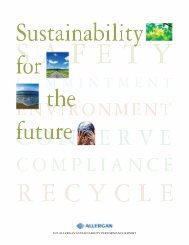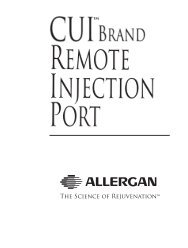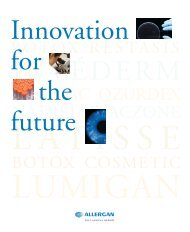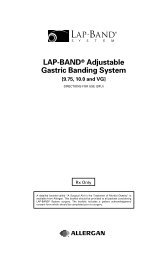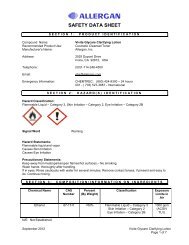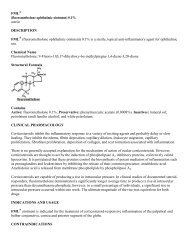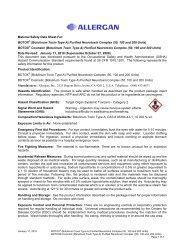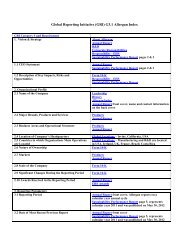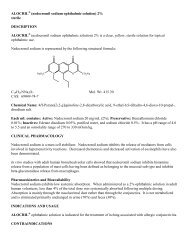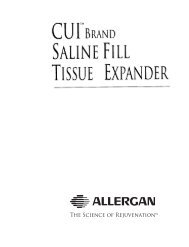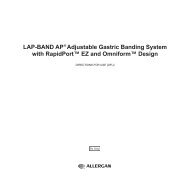Allergan Annual Report - Corporate Solutions
Allergan Annual Report - Corporate Solutions
Allergan Annual Report - Corporate Solutions
Create successful ePaper yourself
Turn your PDF publications into a flip-book with our unique Google optimized e-Paper software.
+to our investorsBusiness conditions in the first half of 2009 were even more challengingthan at the end of 2008. This, in combination with the changingdynamics of today’s health care environment, has required all companiesto take a critical look at their business operations and make adjustmentsin order to continue providing optimal health care solutions for patientswhile building stockholder value. We have used this period of greatchallenge as a catalyst for change, to retool our organization’s skill setsand business practices and to make tough strategic trade-offs to help<strong>Allergan</strong> emerge from the recession as a lean, fit and adaptable company.We have refreshed our thinking about the way we do business and havesharpened our perspective on the best way to meet the needs of all ourstakeholders, starting with the patients who depend on us most forsafe, high-quality products. With patients top of mind, innovationto advance patient care and the strengthening of our informationalsystems and educational initiatives were key areas of focus for<strong>Allergan</strong> in 2009. Coupled with operational flexibility and efficiencies,smart business thinking, and the ability to set clear priorities and followthrough on them, our core values have guided us on the path towardcontinued growth.In 2009 we generated sales growth of 2.5 percent in U.S. Dollars and4.9 percent in local currencies, with a decline in sales of 4.7 percent inU.S. Dollars in the first half of the year versus the prior year but, with thebottoming out of many economies around the globe, a much strongergrowth of 10.0 percent in U.S. Dollars in the second half of the year. Thiswas aided by the weakness of the U.S. Dollar relative to other currenciesand a lapping effect compared to the weak end of 2008. At the beginningof the year, we provided investors with an expected range for adjustedDiluted Earnings per Share (EPS) growth of 5–7 percent. Applying greatoperating discipline, the final result was 8.2 percent growth versus 2008.[A reconciliation between Generally Accepted Accounting Principles(GAAP) Diluted EPS and adjusted Diluted EPS is on pages 4–5.] With thecredit and liquidity shock at the end of 2008, we paid more attention tocash flow generation than ever before. The results were excellent, withoperating cash flow of $1,113 million, and a post-capital expenditurenet cash flow of $1,017 million, a record in the history of <strong>Allergan</strong> andcomfortably surpassing our results prior to the recession.StrategicallyPrepared forthe Health CareMarket of theComing DecadeWith hindsight, it was sound thinking that in early 2009 we preparedfor the worst with a restructuring in February that reduced our globalheadcount by approximately 460 employees (or 5 percent), primarily inthe United States and Europe where the economies were most affectedby the recession. We also instituted broad cost containment measures,renegotiated terms with our principal vendors, subjecting any use ofconsultants and contractors to rigorous management scrutiny, andevaluated every possible way to create efficiencies while ensuring thatwe stayed on course with our business strategy and commitmentsto physicians and patients. Regarding manufacturing, we were ableto reduce the average cost of product produced by 4 percent versus2008 by applying a host of techniques from renegotiating raw materialcontracts, improving line speeds and yields, and applying overallprinciples of Lean Manufacturing to our processes. Our intent was topreserve essential expenditures in Research and Development (R&D)and higher return sales and marketing programs, while leveraginginvestments made during the earlier years of buoyant growth. Therestructuring was concentrated and targeted in two areas: the urologysales force in the United States, where we made the strategic decisionto withdraw from a direct detailing presence in the general practitionerchannel; and in marketing support functions in the United States andEurope. We also benefited from a decision made in early 2008 toclose our breast implant manufacturing facility in Arklow, Ireland, andconcentrate all global production in our existing, expanded low-costfacility in Costa Rica.The global recession had varying impacts on different operatingregions but particularly on our different product lines, which servedto demonstrate the benefits of our diversity both in terms ofbusiness areas, products and geographies. For the full year, basedon internal information and assumptions, approximately 72 percentof <strong>Allergan</strong>’s sales were derived from products reimbursed by privateinsurers or government payors around the world, and 28 percent werebased on cash paid electively by consumers for medical aestheticsprocedures. This compares to a two-thirds/one-third percentage mixprior to the recession, a shift because elective cash pay products weresubject to cutbacks in consumer spending and, as became quite clear inthe downturn, in direct correlation to price. Accordingly, the highest costprocedure, surgery for breast augmentation, was hit the hardest; dermalfillers felt a medium impact; and the lowest cost procedure, BOTOX ®Cosmetic, was by far the most resilient. Beyond medical aesthetics, wewere initially surprised by the weakness of the market and our sales ofobesity intervention products, particularly the LAP-BAND ® AdjustableGastric Banding System. Prior to the recession, about a quarter of thisbusiness was cash pay, and even the reimbursed segment was affectedgiven a typical insurance co-payment in the range of $2,000 to $4,000in the United States.During the first half of 2009 we improved our ability to forecast thespeed of contraction in our product markets, and we also rapidly reapedthe benefits of the vigorous cost savings programs outlined above. Bythe middle of the year, we began to observe a bottoming out of the U.S.economy, resilience in several of the large European economies andcontinuing strength in East Asia and Brazil. Consequently, from thebeginning of the third quarter we made the strategic decision to ramp upDirect to Consumer (DTC) advertising for several of our medical aestheticsbrands including LATISSE ® , RESTASIS ® , our therapeutic dry eye product,JUVEDERM ® , and, for LAP-BAND ® System, to boost sales trajectory inanticipation of market recovery by generating greater awareness amongpatients of their treatment options. Unfortunately we had no FDAapprovedadvertisement available for BOTOX ® Cosmetic. Operationally,DTC is all variable expenditure, and decisions to move spend up or downcan be made on a short-term basis. In the fourth quarter, on risingconfidence in economic recovery, we broadened our spending from DTCalone into other impactful high return marketing programs. We continue,however, to keep an iron grip on spending so that we can lock in thebenefits, learned during the recession, of a lower cost operating model.In the midst of the recession, the fundamentals underpinning thelong-term success of our business model remained top of mind,including our commitment to patients, steady investment, scientificinnovation and global expansion. Key areas of reflection were: how toposition <strong>Allergan</strong> to emerge from the downturn even stronger and, as aspecialist in each of our medical specialties, how to further increase ourstrategic differentiation from our key competitors.STEADY INVESTMENT IN R&D AND SCIENTIFIC INNOVATIONOverall expenditure on R&D, on a non-GAAP adjusted basis, was $675million, a decrease of 7.4 percent versus 2008. [A reconciliation betweenGAAP R&D expenditures and adjusted R&D expenditures is on pages 4–5.]Regarding R&D investment we would have liked to have spent much more.However, 2009 was a transition year as we completed many expensivePhase III trials: OZURDEX for retinal vein occlusion (RVO) and uveitisand, to a lesser extent, ACUVAIL ® and ZYMAR ® X. In addition, in the firstfew months of the year we were cautious about initiating new clinicalstudies given the uncertain economic outlook. But during this period wealso took steps to ensure that a downturn in the economy would notslow innovation or progress in critical research to advance patient care.We made significant efficiency gains in clinical development so that weare now able to obtain much greater output at the same high standardsfor the same level of expenditure. This was achieved with no impact onquality by bringing in-house a greater number of clinical trials, which ismore cost-efficient given that we can leverage our existing infrastructure;by conducting more clinical trials in lower-cost regions overseas; andby negotiating lower-cost contracts with preferred Clinical ResearchOrganization (CRO) partners. In 2009, we were able to enroll 8 percentmore patients per clinical research associate than in 2008. For 2010 wehave further efficiency programs in place to reduce the cost of clinicaltrials, measured by cost per patient enrolled.Even against this background of lower R&D spending, we achieved asteady stream of product approvals in major countries around the world.LUMIGAN ® RC 0.01% was approved in the European Union, Canada andBrazil, and LUMIGAN ® 0.03% was approved in Japan in partnership withSenju Pharmaceutical Co., Ltd. In partnership with GlaxoSmithKline (GSK),BOTOX ® for glabellar lines was approved in China, and in Japan as BOTOXVISTA ® . The French regulatory agency approved BOTOX ® for upper andlower limb spasticity for children. LATISSE ® was approved in Korea, thefirst market to follow the Food and Drug Administration (FDA) approvalin the United States. Our JUVÉDERM ® Ultra and Ultra Plus brands,formulated with lidocaine anesthetic, were launched in Europe andAustralia and in early 2010 were approved in the United States underthe JUVEDERM ® Ultra XC and Ultra Plus XC brands. Additionally,VOLUMA XC incorporating lidocaine was approved in Europe. In theUnited States, major regulatory files were submitted to the FDA in2009: BOTOX ® for chronic migraine, OZURDEX for a new indicationof uveitis and LAP-BAND ® System for morbidly obese adolescents. Inaddition, in 2009 we also responded and liaised with the FDA regardingour 2008 filing for BOTOX ® for spasticity. Due to increasingly challengingregulatory review processes at the FDA, we have not yet receivedapproval for LUMIGAN ® RC 0.01%, nor for the next generation siliconegel shaped breast implant, known as Style 410. Regulatory files forBOTOX ® for chronic migraine were also submitted to the authoritiesin Canada, the United Kingdom, France and Switzerland.As we pursue new solutions for patients through our R&Dprograms, our primary focus is on new glaucoma programs, nextgeneration therapeutic dry eye products, and a next generationof neuromodulators with even more precise targeting ofneurotransmitters. In these endeavors we do not rely upon internalsources of technology alone, but supplement these with researchcollaborations and acquisitions of technology from third parties. Anexample is the acquisition of Serica in early 2010 which brings us uniquesilk mesh-based technology for use in breast reconstruction. With almost$2 billion of cash currently on our balance sheet, we have the strategicflexibility to make further acquisitions to bolster our R&D pipeline andgrowth over the coming years.PROGRESS ON A BROAD FRONTRegarding selling, general and administrative (SG&A) expenditures,adjusted SG&A on a non-GAAP basis increased by 1.1 percent versus2008. [A reconciliation between GAAP SG&A expenditures and adjustedSG&A expenditures is on pages 4–5.] A significant proportion of theincrease was accounted for by the investments in DTC which were ata record $185 million, marking an increase of 47 percent over 2008despite hard economic times and reflecting a conscious decision tospend into the recovery. By targeting our overall sales and marketinginvestments to selected areas, we made great progress on a broad front.Eye care pharmaceuticals, representing 47 percent of worldwiderevenues, increased 4.6 percent in U.S. Dollars and 7.2 percent in localcurrencies. For the eighth consecutive year, <strong>Allergan</strong> has been the fastestgrowing global eye care pharmaceutical company, (1) thanks principallyto RESTASIS ® , our artificial tears brands led by REFRESH ® and OPTIVE,and our glaucoma franchise, led by the worldwide introductions of the(1) Intercontinental Medical Statistics (IMS): 48 countries rollup, YTD Q3 2009.6 allergan annual report 2009 7



